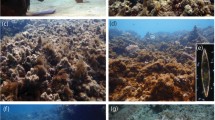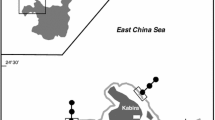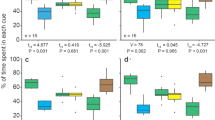Abstract
Marine organisms are under threat globally from a suite of anthropogenic sources, but the current emphasis on global climate change has deflected the focus from local impacts. While the effect of increased sedimentation on the settlement of coral species is well studied, little is known about the impact on larval fish. Here, the effect of a laterite “red soil” sediment pollutant on settlement behaviour and post-settlement performance of reef fish was tested. In aquarium tests that isolated sensory cues, we found significant olfaction-based avoidance behaviour and disruption of visual cue use in settlement-stage larval fish at 50 mg L−1, a concentration regularly exceeded in situ during rain events. In situ light trap catches showed lower abundance and species richness in the presence of red soil, but were not significantly different due to high variance in the data. Prolonged exposure to red soil produced altered olfactory cue responses, whereby fish in red soil made a likely maladaptive choice for dead coral compared to controls where fish chose live coral. Other significant effects of prolonged exposure included decreased feeding rates and body condition. These effects on fish larvae reared over 5 days occurred in the presence of a minor drop in pH and may be due to the chemical influence of the sediment. Our results show that sediment pollution of coral reefs may have more complex effects on the ability of larval fish to successfully locate suitable habitat than previously thought, as well as impacting on their post-settlement performance and, ultimately, recruitment success.





Similar content being viewed by others
References
Almany GR, Webster MS (2006) The predation gauntlet: early post-settlement mortality in reef fishes. Coral Reefs 25:19–22. doi:10.1007/s00338-005-0044-y
Arakaki T et al (2005) Simultaneous measurement of hydrogen peroxide and Fe species (Fe(II) and Fe(tot)) in Okinawa Island Seawater: impacts of red soil pollution. J Oceanogr 61:561–568
Bak RP (1978) Lethal and sublethal effects of dredging on reef corals. Mar Pollut Bull 9:14–16. doi:10.1016/0025-326X(78)90275-8
Baumann H, Talmage SC, Gobler CJ (2012) Reduced early life growth and survival in a fish in direct response to increased carbon dioxide. Nat Clim Change 2:38–41. doi:10.1038/nclimate1291
Bégin C, Brooks G, Larson RA, Dragićević S, Ramos Scharrón CE, Côté IM (2014) Increased sediment loads over coral reefs in Saint Lucia in relation to land use change in contributing watersheds. Ocean Coast Manag 95:35–45. doi:10.1016/j.ocecoaman.2014.03.018
Bergenius MA, Meekan MG, Robertson RD, McCormick MI (2002) Larval growth predicts the recruitment success of a coral reef fish. Oecologia 131:521–525. doi:10.1007/s00442-002-0918-4
Briffa M, de la Haye K, Munday PL (2012) High CO2 and marine animal behaviour: potential mechanisms and ecological consequences. Mar Pollut Bull 64:1519–1528. doi:10.1016/j.marpolbul.2012.05.032
Cowen R, Paris C, Srinivasan A (2006) Scaling of connectivity in marine populations. Science 311:522–527
Cripps IL, Munday PL, McCormick MI (2011) Ocean acidification affects prey detection by a predatory reef fish. PLoS ONE 6:e22736. doi:10.1371/journal.pone.0022736
Dixson DL, Munday PL, Jones GP (2010) Ocean acidification disrupts the innate ability of fish to detect predator olfactory cues. Ecol Lett 13:68–75. doi:10.1111/j.1461-0248.2009.01400.x
Dixson DL, Abrego D, Hay ME (2014) Chemically mediated behavior of recruiting corals and fishes: a tipping point that may limit reef recovery. Science 345:892–897. doi:10.1126/science.1255057
Edinger EN, Risk MJ (2013) Effect of land-based pollution on central Java coral reefs. Coast Dev 3:593–613
Erftemeijer PL, Riegl B, Hoeksema BW, Todd PA (2012) Environmental impacts of dredging and other sediment disturbances on corals: a review. Mar Pollut Bull 64:1737–1765. doi:10.1016/j.marpolbul.2012.05.008
Fabricius KE (2005) Effects of terrestrial runoff on the ecology of corals and coral reefs: review and synthesis. Mar Pollut Bull 50:125–146
Feary DA, Almany GR, McCormick MI, Jones GP (2007) Habitat choice, recruitment and the response of coral reef fishes to coral degradation. Oecologia 153:727–737. doi:10.1007/s00442-007-0773-4
Fiksen Ø, Aksnes DL, Flyum MH, Giske J (2002) The influence of turbidity on growth and survival of fish larvae: a numerical analysis. Sustainable increase of marine harvesting: fundamental mechanisms and new concepts. Springer, Berlin, pp 49–59
Fisher HS, Wong BB, Rosenthal GG (2006) Alteration of the chemical environment disrupts communication in a freshwater fish. Proc R Soc B 273:1187–1193. doi:10.1098/rspb.2005.3406
Galloway TS et al (2004) Ecosystem management bioindicators: the ECOMAN project—a multi-biomarker approach to ecosystem management. Mar Environ Res 58:233–237. doi:10.1016/j.marenvres.2004.03.064
Gerlach G, Atema J, Kingsford MJ, Black KP, Miller-Sims V (2007) Smelling home can prevent dispersal of reef fish larvae. Proc Natl Acad Sci USA 104:858–863. doi:10.1073/pnas.0606777104
Higashi T, Katayama TC, Shinagawa A (1985) Land development works and soil erosion in Okinawa Prefecture. Mem Kagoshima Univ Res Center S Pac 6:26–36
Hughes TP, Graham NA, Jackson JB, Mumby PJ, Steneck RS (2010) Rising to the challenge of sustaining coral reef resilience. Trends Ecol Evol 25:633–642. doi:10.1016/j.tree.2010.07.011
Jutfelt F, de Souza KB, Vuylsteke A, Sturve J (2013) Behavioural disturbances in a temperate fish exposed to sustained high-CO2 levels. PLoS ONE 8:e65825. doi:10.1371/journal.pone.0065825
Kingsford MJ, Leis JM, Shanks A, Lindeman KC, Morgan SG, Pineda J (2002) Sensory environments, larval abilities and local self-recruitment. Bull Mar Sci 70:309–340
Klaprat DA, Brown SB, Hara TJ (1988) The effect of low pH and aluminum on the olfactory organ or rainbow trout Salmo gairdneri. Environ Biol Fishes 22:69–78. doi:10.1007/BF00000544
Kombo MM, Vuai SA, Ishiki M, Tokuyama A (2005) Influence of salinity on pH and aluminum concentration on the interaction of acidic red soil with seawater. J Oceanogr 61:591–601. doi:10.1007/s10872-005-0067-6
Kroon FJ (2005) Behavioural avoidance of acidified water by juveniles of four commercial fish and prawn species with migratory life stages. Mar Ecol Prog Ser 285:193–204
Lecchini D, Osenberg CW, Shima JS, St Mary CM, Galzin G (2007) Ontogenetic changes in habitat selection during settlement in a coral reef fish: ecological determinants and sensory mechanisms. Coral Reefs 26:423–432. doi:10.1007/s00338-007-0212-3
Lecchini D, Waqalevu VP, Parmentier E, Radford CA, Banaigs B (2013) Fish larvae prefer coral over algal water cues: implications of coral reef degradation. Mar Ecol Prog Ser 475:303–307
Lecchini D, Miura T, Lecellier G, Banaigs B, Nakamura Y (2014a) Transmission distance of chemical cues from coral habitats: implications for marine larval settlement in context of reef degradation. Mar Biol 161:1677–1686
Lecchini D, Peyrusse K, Lanyon RG, Lecellier G (2014b) Importance of visual cues of conspecifics and predators during the habitat selection of coral reef fish larvae. C R Biol 337:345–351. doi:10.1016/j.crvi.2014.03.007
Leis JM, Yerman MN (2012) Behavior of larval butterflyfishes (Teleostei, Chaetodontidae) at settlement on coral reefs. Copeia 2012:212–222. doi:10.1643/CE-10-185
Leis JM, Carson-Ewart BM, Cato DH (2002) Sound detection in situ by the larvae of a coral-reef damselfish (Pomacentridae). Mar Ecol Prog Ser 232:259–268
Mkadam KM, Yonaha T, Ali VS, Tokuyama A (2006) Dissolved aluminum and silica release on the interaction of Okinawan subtropical red soil and seawater at different salinities: experimental and field observations. Geochem J 40:333–343. doi:10.2343/geochemj.40.33
Mora C et al (2011) Global human footprint on the linkage between biodiversity and ecosystem functioning in reef fishes. PLoS Biol 9:e1000606. doi:10.1371/journal.pbio.1000606
Munday PL et al (2009) Ocean acidification impairs olfactory discrimination and homing ability of a marine fish. Proc Natl Acad Sci USA 106:1848–1852. doi:10.1073/pnas.0809996106
Munday PL et al (2013) Elevated CO2 affects the behavior of an ecologically and economically important coral reef fish. Mar Biol 160:2137–2144. doi:10.1007/s00227-012-2111-6
Nakamura Y, Shibuno T, Lecchini D, Kawamura T, Watanabe Y (2009) Spatial variability in habitat associations of pre- and post-settlement stages of coral reef fishes at Ishigaki Island, Japan. Mar Biol 156:2413–2419. doi:10.1007/s00227-009-1257-3
Nanami A, Nishihira M (2002) The structures and dynamics of fish communities in an Okinawan coral reef: effects of coral-based habitat structures at sites with rocky and sandy sea bottoms. Environ Biol Fishes 63:353–372
Nilsson GE et al (2012) Near-future carbon dioxide levels alter fish behaviour by interfering with neurotransmitter function. Nat Clim Change 2:201–204. doi:10.1038/nclimate1352
Okinawa Prefecture (1993) Survey report on the state of red soil pollution and its damage. Department of Health and Environment Okinawa, Naha, p 204
Omori M (2011) Degradation and restoration of coral reefs: experience in Okinawa, Japan. Mar Biol Res 7:3–12. doi:10.1080/17451001003642317
Powell B, Martens M (2005) A review of acid sulfate soil impacts, actions and policies that impact on water quality in Great Barrier Reef catchments, including a case study on remediation at East Trinity. Mar Pollut Bull 51:149–164. doi:10.1016/j.marpolbul.2004.10.047
Scott GR, Sloman KA (2004) The effects of environmental pollutants on complex fish behaviour: integrating behavioural and physiological indicators of toxicity. Aquat Toxicol 68:369–392. doi:10.1016/j.aquatox.2004.03.016
Shima JS, Findlay AM (2002) Pelagic larval growth rate impacts benthic settlement and survival of a temperate reef fish. Mar Ecol Prog Ser 235:303–309
Siebeck UE, O’Connor J, Braun C, Leis JM (2015) Do human activities influence survival and orientation abilities of larval fishes in the ocean? Integr Zool 10:65–82. doi:10.1111/1749-4877.12096
Thorrold SR, Milicich MJ (1990) Comparison of larval duration and pre- and post-settlement growth in two species of damselfish, Chromis atripectoralis and Pomacentrus coelestis (Pisces: Pomacentridae) from the Great Barrier Reef. Mar Biol 105:375–384. doi:10.1007/BF01316308
Torres JL, Morelock J (2002) Effect of terrigenous sediment influx on coral cover and linear extension rates of three Caribbean massive coral species. Caribb J Sci 38:222–229
Ward AJ, Duff AJ, Horsfall JS, Currie S (2008) Scents and scents-ability: pollution disrupts chemical social recognition and shoaling in fish. Proc R Soc B 275:101–105. doi:10.1098/rspb.2007.1283
Weber M et al (2012) Mechanisms of damage to corals exposed to sedimentation. Proc Natl Acad Sci USA 109:E1558–E1567. doi:10.1073/pnas.1100715109
Wenger AS, McCormick MI (2013) Determining trigger values of suspended sediment for behavioral changes in a coral reef fish. Mar Pollut Bull 70:73–80. doi:10.1016/j.marpolbul.2013.02.014
Wenger AS, Johansen J, Jones G (2011) Suspended sediment impairs habitat choice and chemosensory discrimination in two coral reef fishes. Coral Reefs 30:879–887. doi:10.1007/s00338-011-0773-z
Wenger AS, Johansen JL, Jones GP (2012) Increasing suspended sediment reduces foraging, growth and condition of a planktivorous damselfish. J Exp Mar Biol Ecol 428:43–48. doi:10.1016/j.jembe.2012.06.004
Wenger A, McCormick M, McLeod I, Jones G (2013) Suspended sediment alters predator–prey interactions between two coral reef fishes. Coral Reefs 32:369–374. doi:10.1007/s00338-012-0991-z
Wenger A, McCormick M, Endo G, McLeod I, Kroon F, Jones G (2014) Suspended sediment prolongs larval development in a coral reef fish. J Exp Biol 217:1122–1128. doi:10.1242/jeb.094409
Wong CK, Pak IAP, Jiang Liu X (2013) Gill damage to juvenile orange-spotted grouper Epinephelus coioides (Hamilton, 1822) following exposure to suspended sediments. Aquac Res 44:1685–1695. doi:10.1111/j.1365-2109.2012.03173.x
Acknowledgments
The authors would like to thank the staff at the Tropical Biosphere Research Centre (University of the Ryukyus) for their logistical support, and the Australian Museum, the Sydney Institute of Marine Science and the University of Technology Sydney for their financial support. We also thank Ryuta Suzuki and Yasuaki Tanaka for assistance with the field and laboratory experiments. This research was carried out in accordance with Japanese law and was supported by the Japan Society for the Promotion of Science (Grant No. 24780188). All applicable institutional and/or national guidelines for the care and use of animals were followed.
Author information
Authors and Affiliations
Corresponding author
Additional information
Communicated by Deron E. Burkepile.
Electronic supplementary material
Below is the link to the electronic supplementary material.
Rights and permissions
About this article
Cite this article
O’Connor, J.J., Lecchini, D., Beck, H.J. et al. Sediment pollution impacts sensory ability and performance of settling coral-reef fish. Oecologia 180, 11–21 (2016). https://doi.org/10.1007/s00442-015-3367-6
Received:
Accepted:
Published:
Issue Date:
DOI: https://doi.org/10.1007/s00442-015-3367-6




